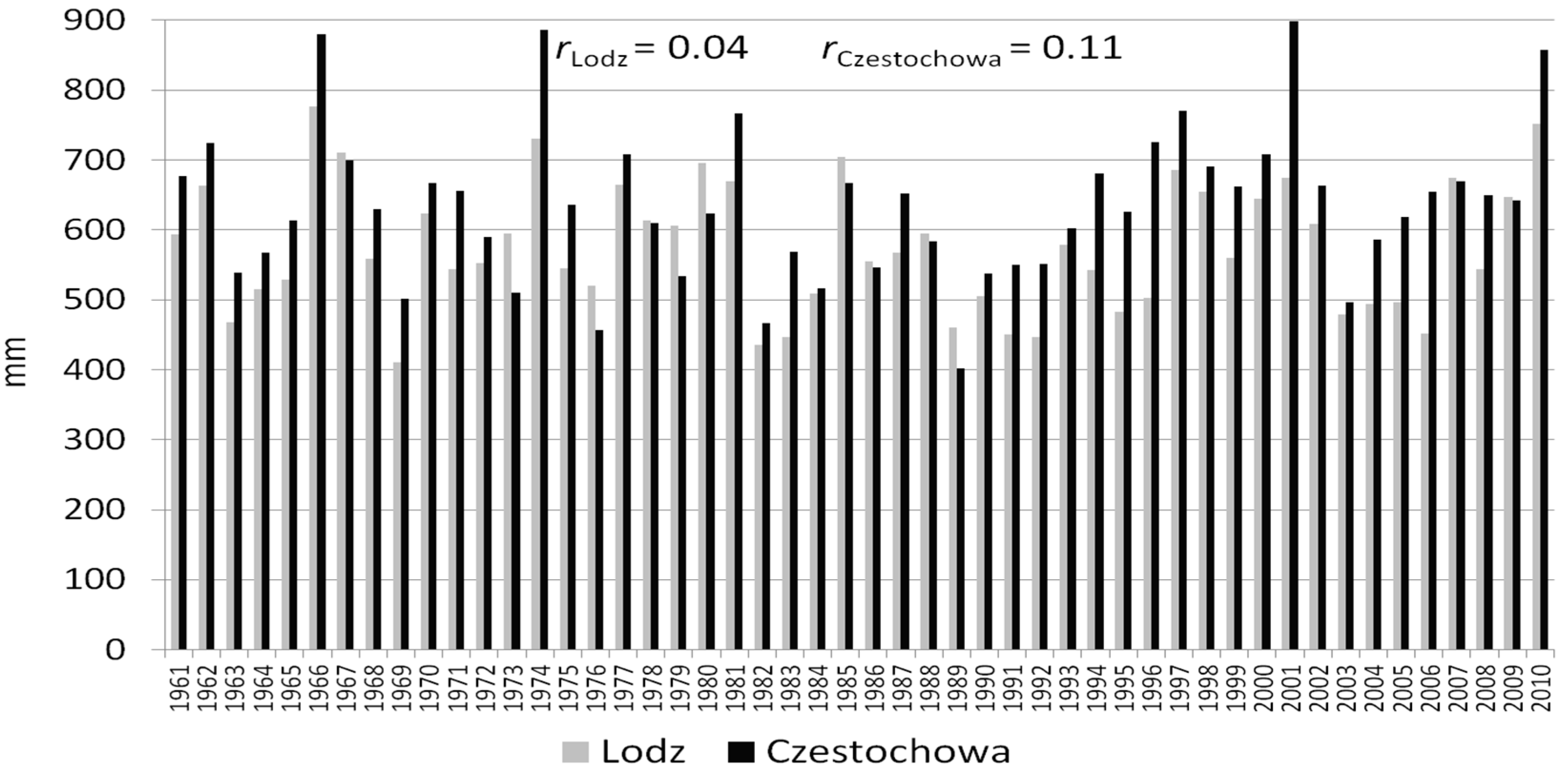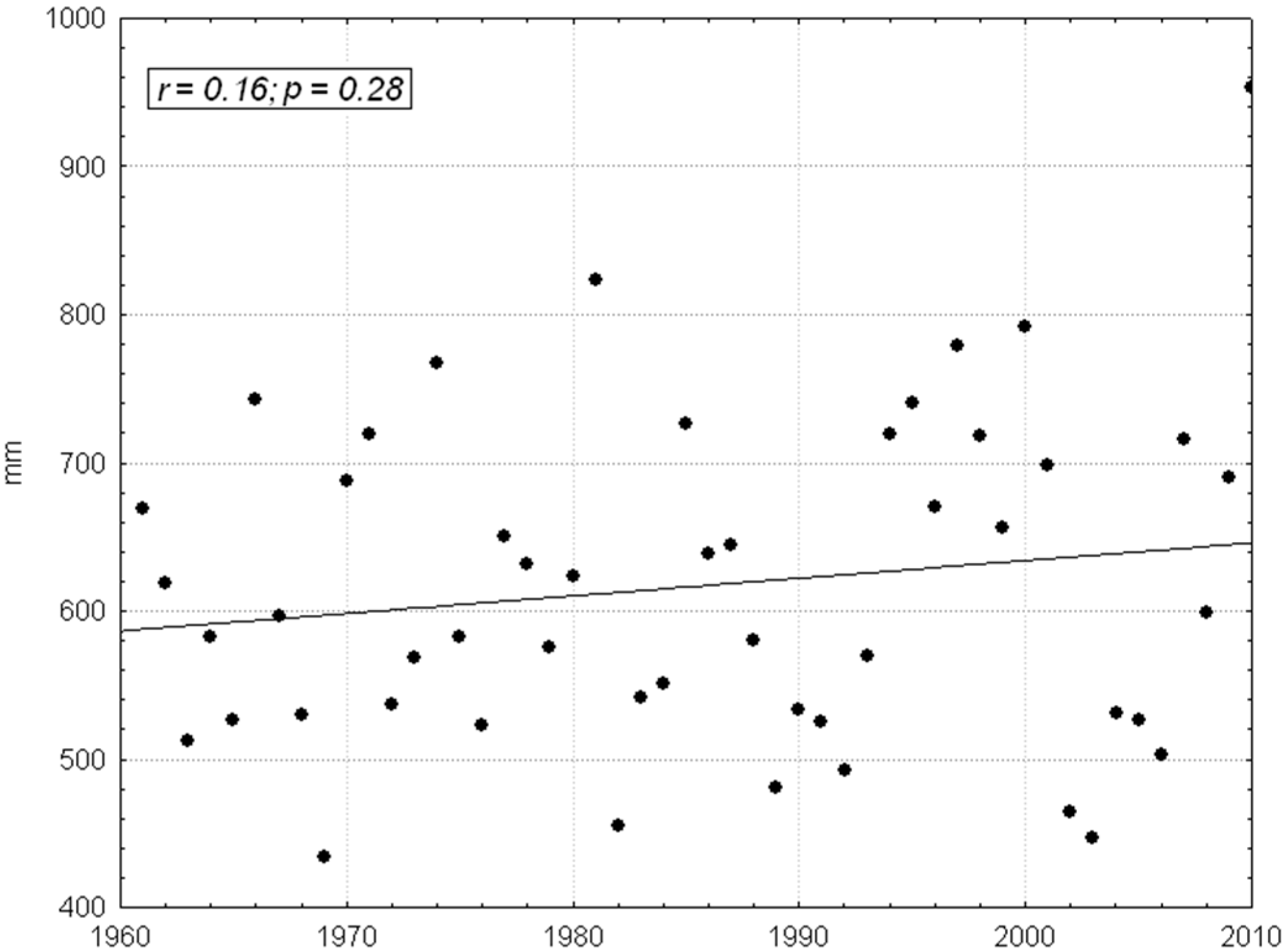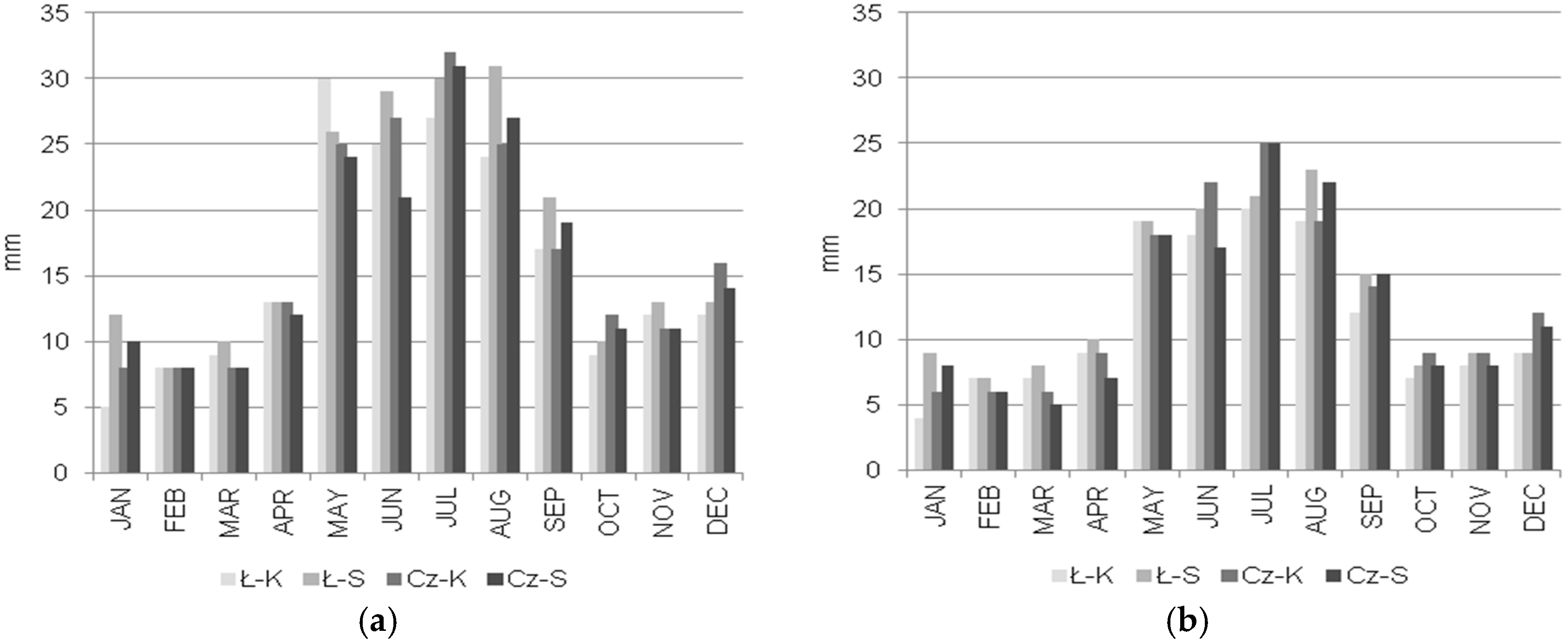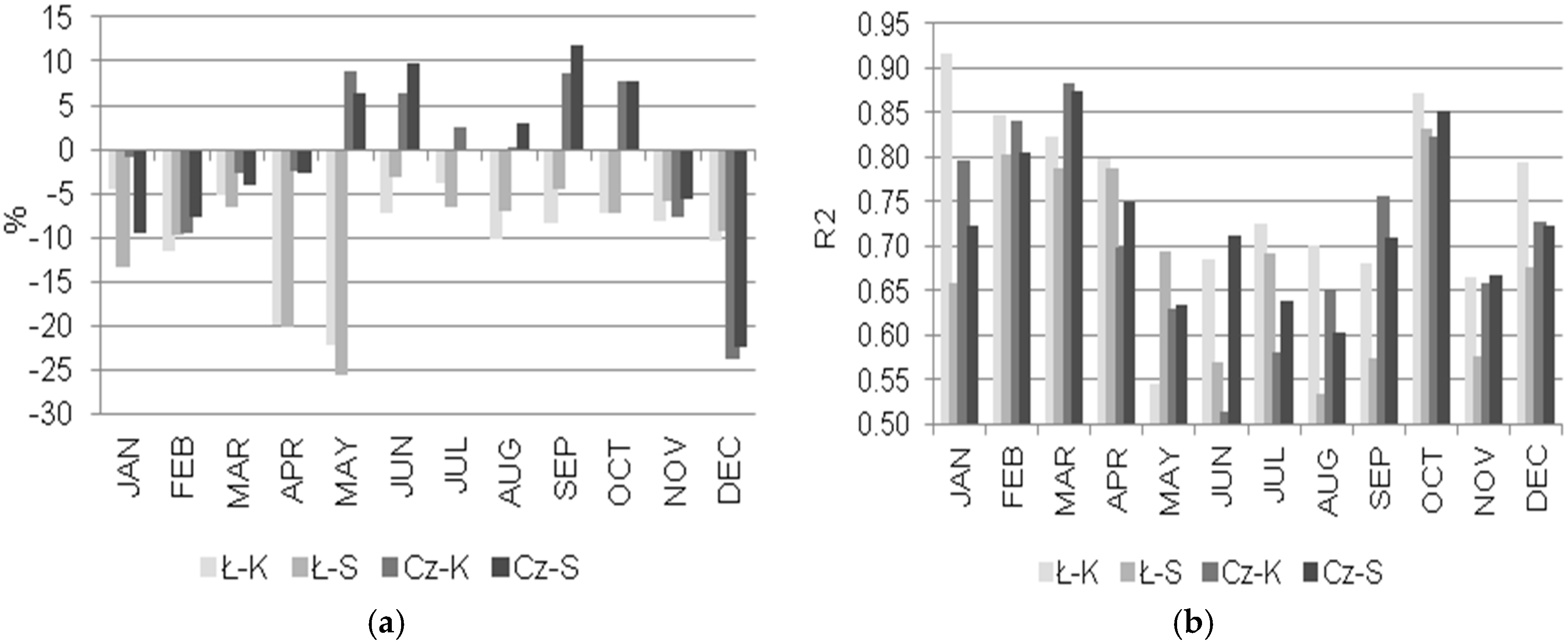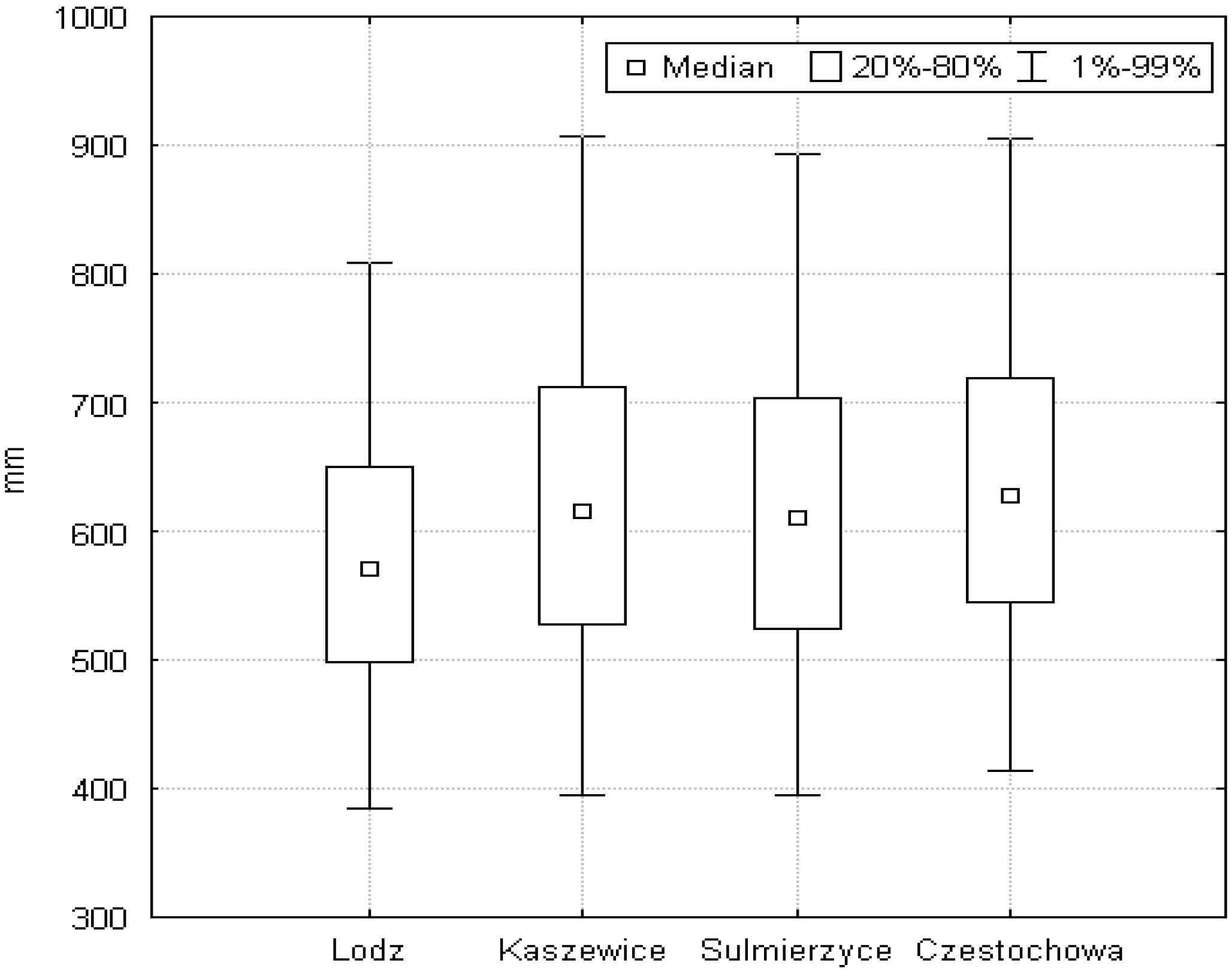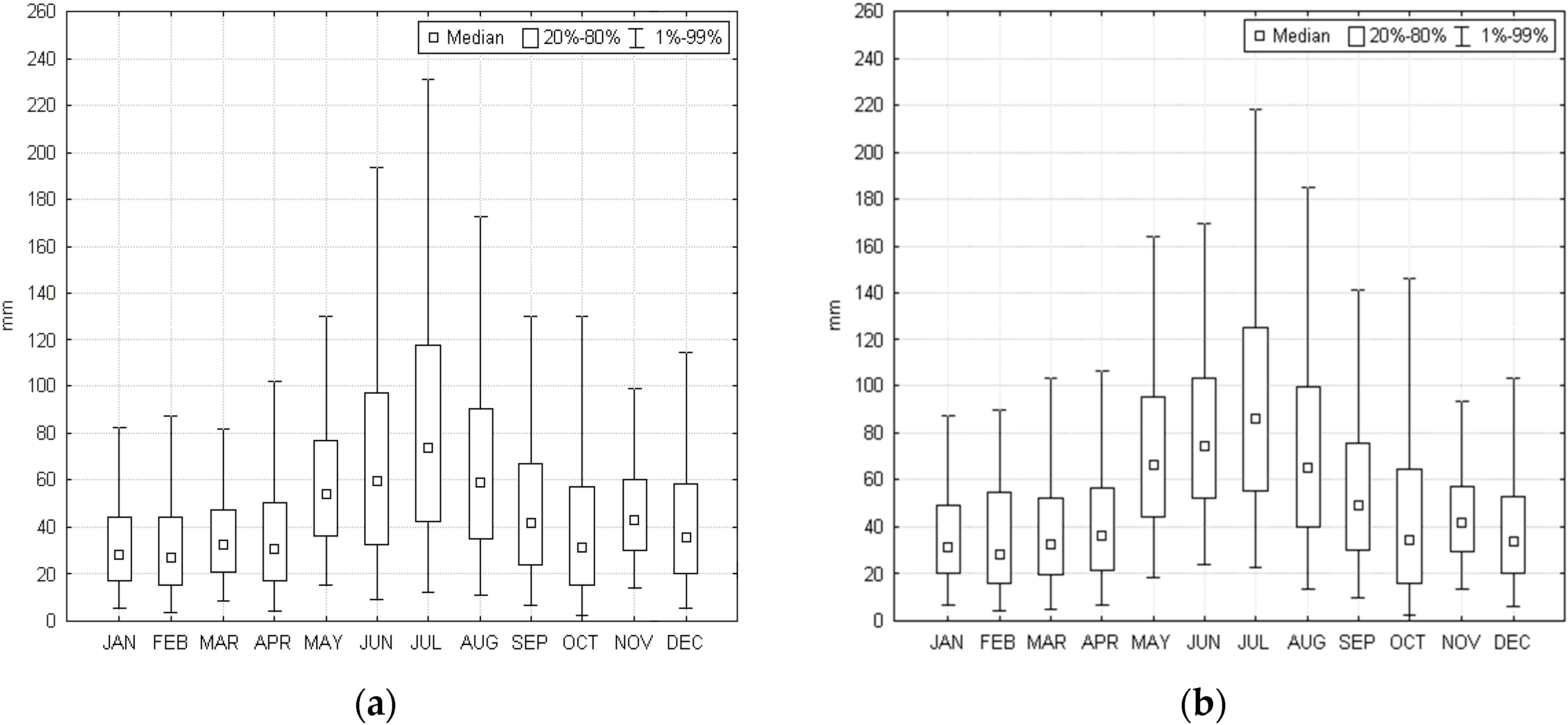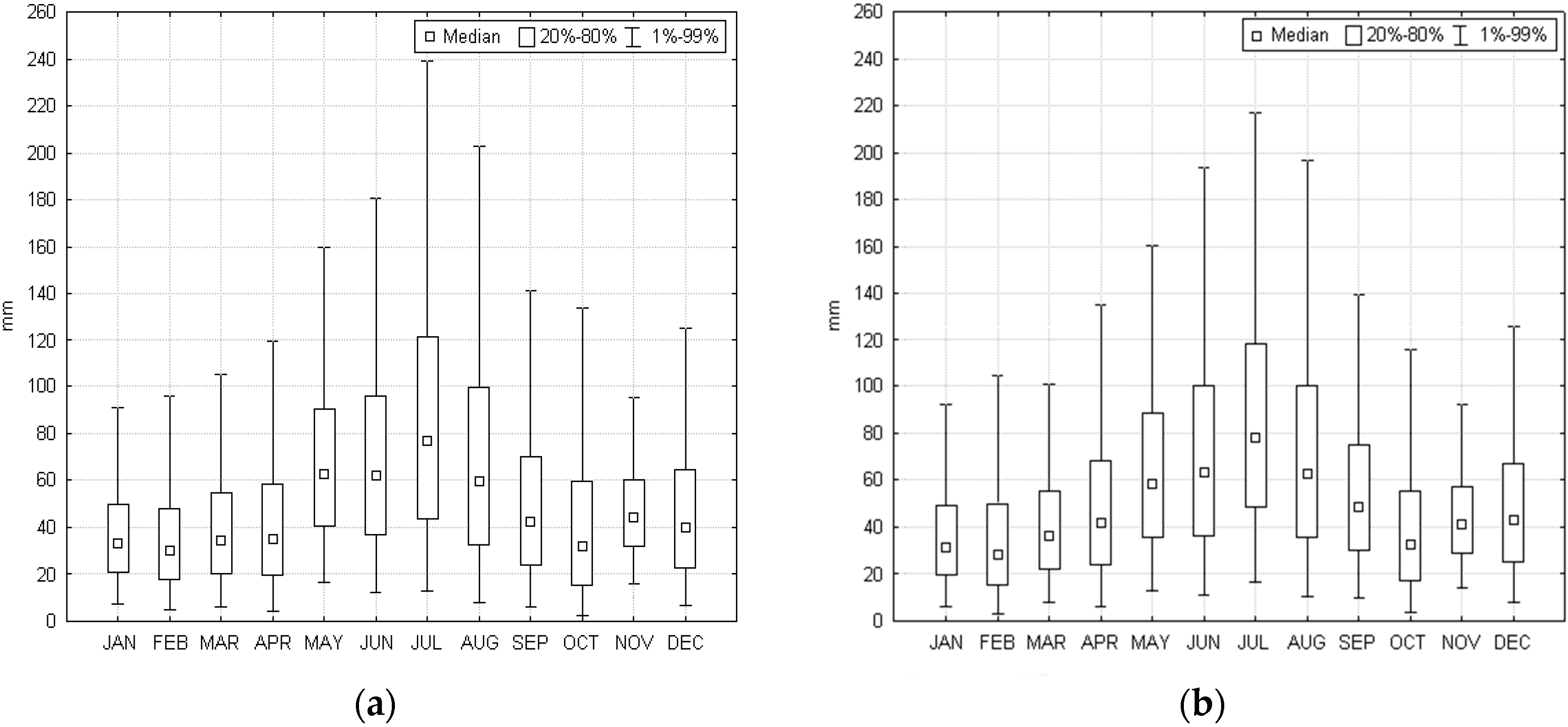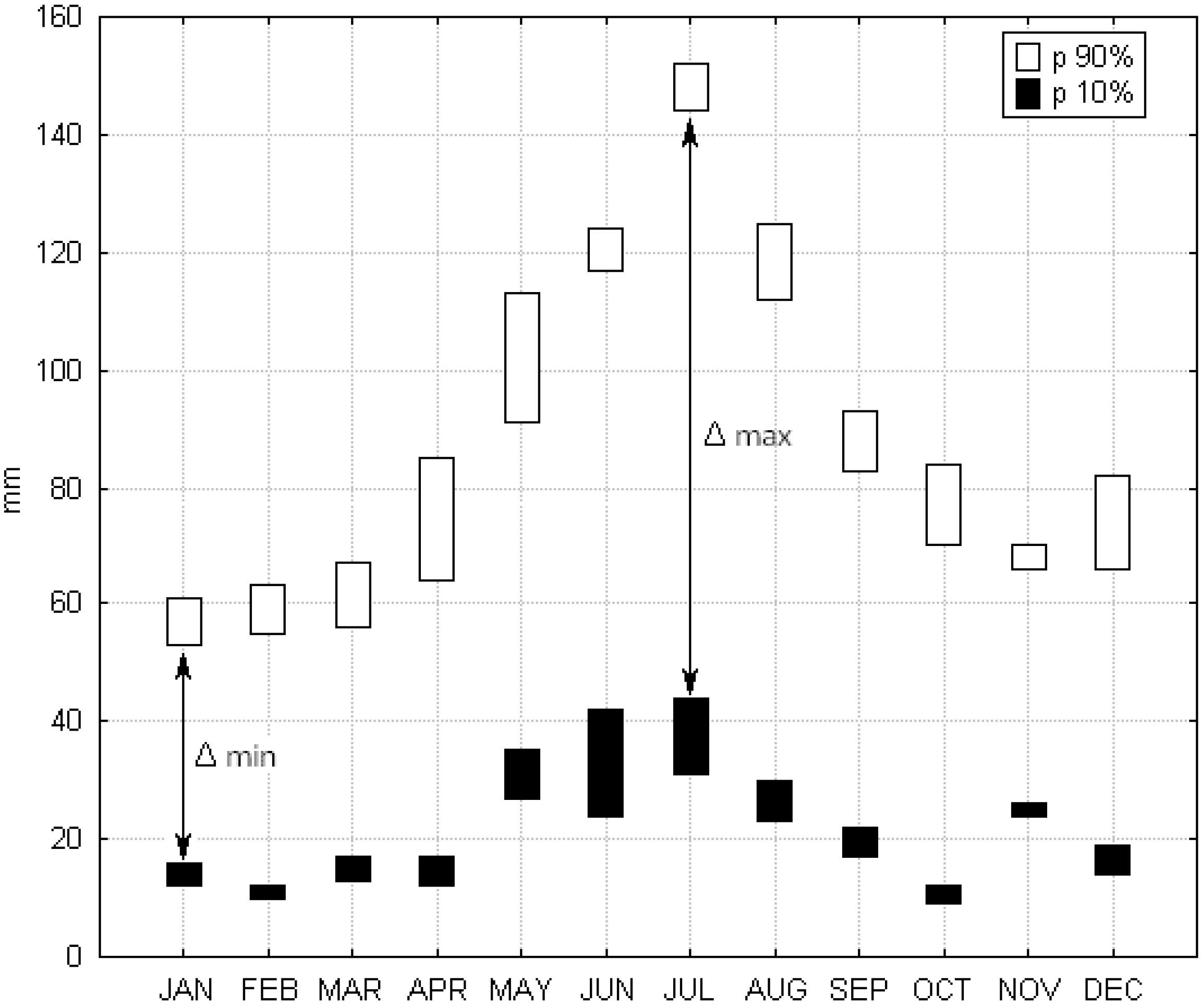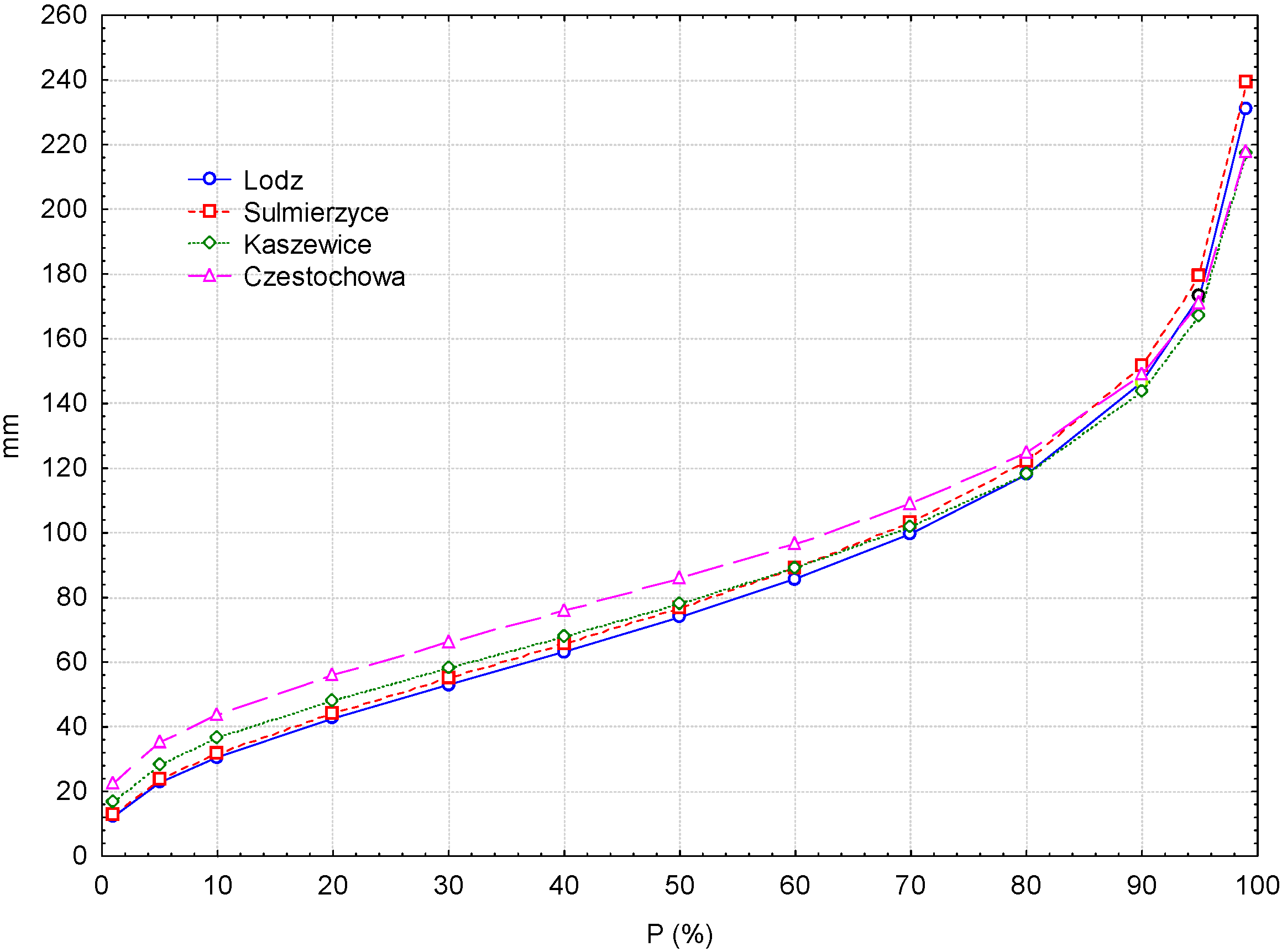4.1. Average Annual and Monthly Precipitation Totals
The spatial distribution of average annual precipitation totals during 1961–2010 indicates increasing values to the south. The lowest average annual precipitation total has been recorded in Lodz, and the highest in Czestochowa. The average difference equal to 59 mm was found between these two weather stations. Average annual precipitation totals in Kaszewice, Sulmierzyce and Czestochowa were similar and the maximum difference between these three stations was only 17 mm. The lowest variability of annual precipitation was marked in Lodz (
SD = 93 mm), while the largest was marked at two weather stations located close to the mine area—Kaszewice and Sulmierzyce (
Table 3).
The analysed region was also characterised by high temporal variability of monthly precipitation totals (
Table 3). At all stations, the highest long term average sums were recorded in July and lowest in February. The
SD values from May to October, with maximum also in July, were higher than in the other months pointing out the high variability of precipitation between succeeding years in this period. In winter, the greatest variability of precipitation was observed in December and the lowest generally in January and February. The same regularity was found for monthly precipitation in Lodz in the years 1904–2006 [
18].
In Lodz, the monthly precipitation totals and their variability were the lowest. June was the exception because this station experienced greater rainfall variability (SD = 41 mm) than the others. Czestochowa stood out with the highest rainfall from May to October, although the variability was generally lower than that observed at the meteorological stations.
There were generally no statistically significant trends (α = 0.05) in annual precipitation totals for the analysed weather stations. These are presented in
Figure 2 for the synoptic stations and in
Figure 3 for the station in Sulmierzyce. For Kaszewice, which has a shorter data series, a significant trend (
r = 0.34,
p = 0.04) was found. For monthly precipitation in only four cases significant trends were found. Ilnicki et al. [
31] analysing the long data series of precipitation for Lodz (years 1904–2010) and Czestochowa (years 1891–2010) also did not find statistically significant trends.
4.2. Extreme Annual and Monthly Precipitation Totals
The highest annual precipitation totals were recorded in 2010 at Kaszewice (934 mm) and Sulmierzyce (953 mm) stations, located in the LMB impact area. These amounts were more comparable to the maximum annual total at Czestochowa than Lodz (
Table 4). Even though Lodz has generally the smallest amount of rain, it had the highest maximum totals in June, July and August out of the four weather stations. The value of 268 mm registered at this station in July 1997 was the highest monthly sum recorded in the studied area within the last 50 years. The precipitation total exceeded 120 mm in Kaszewice in December 2005, indicating that the maximum monthly sum may exceed more than 2.5 times the average value even in the winter months. In the examined long-term period, 40% of the maximum monthly sums occurred in the first decade of the 21st century.
At each station, the minimum monthly precipitation from January to April were very low (<10 mm) and, in April 2009, imperceptible (1–3 mm). The minimum precipitation in October was ≤5 mm. Twenty-five per cent of the minimum monthly values occurred in the first decade of the twenty-first century (
Table 5). These amounts are unfavourable for crop production in spring and autumn (germination and early tillering of winter crops) and for crops winter survival (lack of snow cover).
The analysis of the data displayed in
Table 4 and
Table 5 shows a large range of variation (the difference between the maximum and minimum) in annual and monthly precipitation totals. As mentioned above, the largest share of extreme sums were recorded in the last two decades. This phenomenon may indicate the on-going climate changes towards increasing frequency of extreme precipitation events. De Luis et al. [
14] analysing long-time data series of precipitation (1946–2005) in Spain detected also a general increase of precipitation concentration in the most recent period. The results published in the report of the European Academies Science Advisory Council [
32] indicate the increase in the frequency of extreme weather events (including extremely high precipitation) in recent decades. Furthermore, the climate models suggest more frequent droughts in the future throughout Europe, intense precipitation events are also likely to be more frequent [
33]. In the north of Europe the positive trend is more significant for extremes than for mean precipitation along the year [
34].
4.3. Compatibility of the Annual and Monthly Precipitation Totals between the Synoptic and Meteorological Stations
Analysis of the agreement (compatibility) between precipitation totals at the synoptic and meteorological stations was performed using statistical measures (RMSE, MAE, PBIAS and
R2) on the equal length of the data series (1976–2010). Summary of the results was prepared separately by combining measures expressed in mm (RMSE and MAE) and PBIAS with
R2 (
Table 6,
Figure 4 and
Figure 5). The values of RMSE and MAE may be regarded as small when these are less than half of the standard deviation of the observed values [
27].
In the case of the annual totals, the lowest RMSE, MAE and PBIAS and the highest value of
R2 were found for the relationship between the synoptic station in Czestochowa and meteorological station in Kaszewice. Especially low PBIAS was found between the precipitation total at Czestochowa and the precipitation totals at both meteorological stations. The poor compatibility defined with the evaluation statistics was found between Lodz and the meteorological stations. The station in Czestochowa better than Lodz represented annual precipitation conditions in the LMB impact area (
Table 6).
The RMSE and MAE were the largest during the summer season in May, June, July and August (
Figure 4), which may be associated with high precipitation totals in these months, and their high spatial variability in comparison to the other months (see
Table 3). Major differences were found between the values of RMSE and MAE in the above mentioned months, which may indicate large variability in precipitation at the compared stations. The RMSE and MAE for each month were set together with the corresponding values of half of
SD for monthly precipitation totals at the synoptic stations. The station in Czestochowa better represented precipitation totals than the station in Lodz registered at the meteorological stations in January, February, March and October, according to the more sensitive statistic RMSE. However, the station in Lodz in June and July was more representative for the meteorological stations, according to the MAE.
In most of the months, PBIAS ranged between +10% and −10%. The PBIAS was below −20% only in April and May in the relationship between Lodz and the meteorological stations, and in December in the relationship between Czestochowa and the meteorological stations. Negative values of PBIAS indicate that on average the precipitation totals recorded at the synoptic stations were lower than at the meteorological stations. In most cases, better compatibility was found between the synoptic station in Czestochowa and both meteorological stations, as evidenced by the low values of PBIAS (
Figure 5a). In general, the lowest values were calculated for PBIAS in July, which in Poland is usually the wettest month of the year. PBIAS tended to vary more during dry months than during the wet ones. The same tendency was found for stream flows by Gupta et al. [
26].
Large values (>0.80) of
R2 in February, March and October indicate that precipitation totals at the synoptic and meteorological stations were more consistent than in the other months. This means that more than 80% of the variation of precipitation totals in these months at the synoptic stations explains variation of precipitation totals at the meteorological stations. The lowest values of
R2 for the relationship between the synoptic and meteorological stations were found for the period from May to August (
Figure 5b). In these months the RMSE and MAE were the greatest, confirming a high difference in precipitation totals between the synoptic stations and meteorological ones. The main reason for great variability of precipitation in warm-season is greater than in cold-season share of convective rainfalls (including thunderstorms). In Poland, convective type of precipitation occurs over the whole year but its frequency is higher in summer than in winter.
At the annual scale, Czestochowa better represented the precipitation conditions at both meteorological stations than Lodz. In July, the month with the highest variability of precipitation, it was more evident for Lodz. To characterise precipitation patterns of the LMB region, which is vulnerable to climate-related hazards, data from both synoptic stations should be taken into account and recommended. These stations have long-term data series and are of a higher order of magnitude (importance) compared to the meteorological stations.
4.4. Monthly Precipitation Patterns and Non-Exceedance Probability Distibution (p, %)
To determine the risk of extremely low and high monthly precipitation, we tested the compatibility of the theoretical normal and gamma distributions with empirical data series using Pearson’s chi-squared test.
The consistency of empirical data distribution was tested with the theoretical normal and gamma distributions, separately. It was assumed, at the significance level α = 0.05, a null hypothesis (H0) that the distribution is normal or gamma and an alternative hypothesis (H1) on the rejection of the H0. The p-values greater than 0.05 indicated no basis to reject the H0.
The majority of tested monthly data series was described by the gamma distribution (compare
Table 7 with
Table 8). The gamma distribution is one-sidedly bounded with zero value and provides relatively good compatibility with empirical data. It is widely used to estimate a probability of precipitation totals within a specified range [
35,
36,
37,
38,
39]. Its shape is similar to the one of precipitation data histograms.
Górski [
38] found that in the weather conditions of Poland annual precipitation totals can be described by the normal as well as the gamma distribution, but monthly sums are evidently asymmetric, thus better described by the gamma distribution. In addition, analysis of multi-annual monthly precipitation totals for 32 meteorological stations in the Bashkortostan Republic (Russian Federation) revealed that all data series had the gamma distribution [
40].
On the basis of gamma distribution we determined different non-exceedance probability of monthly precipitation totals. Considering water needs of crops and the risk of agricultural drought we examined monthly sums at probability p ≤ 20% in details. Taking into account the safety of the LMB and need for constant drainage (dewatering) of the lignite deposit, precipitation totals at p ≥ 80% were also recognised.
The probability of non-exceedance at
p = 1%, 20%, 50%, 80% and 99% are presented on box-and-whiskers plots (
Figure 6,
Figure 7 and
Figure 8). The lower part of the box presents the precipitation sum which together with lower values occur with a frequency of ≤20% (precipitation shortage). The upper part of the box shows the precipitation totals at
p = 80%, the threshold value determining precipitation excess. The lower (bottom) whisker presents the extremely low precipitation (
p = 1%) and the upper whisker indicates the extremely high precipitation (
p = 99%). The point inside the box indicates the median.
The gradation of annual and monthly precipitation totals at different non-exceedance probability for all of the weather stations was generally the same as the long-term average sums (i.e., from the lowest in Lodz to the highest in Czestochowa). The median values were generally lower than the average monthly and annual totals, pointing to the right asymmetry of the frequency distribution. These asymmetries were more evident for the monthly sums distribution than for annual sums.
According to the non-exceedance probability, the lowest annual precipitation totals amounting from 384 mm in Lodz to 414 mm in Czestochowa can be expected once over the hundred years (
p = 1%). At
p = 99% (also once over the 100 years), extremely high annual precipitation amount from 808 in Lodz to 908 mm in Kaszewice. The maximum annual precipitation totals (see
Table 4) recorded in Kaszewice and Sulmierzyce in 2010 were even higher (
p > 99%) and amounted 934 and 953 mm, respectively. The annual precipitation totals in Lodz diverge from precipitation at other stations (
Figure 6).
For the monthly sums, the distance between the median and the bottom part of the box and the bottom whisker is visibly shorter than the distance between median and the upper part of the box and the upper whisker, indicating lower variability of precipitation sum in the periods with precipitation shortage.
The distribution of precipitation for very dry, abnormally dry and extremely dry months (
p ≤ 20%) is characterised by lower dispersion of values compared to wet months (
p ≥ 80%) at all four weather stations (
Figure 7 and
Figure 8). This also results from the applied gamma distribution and indicates lower variability of precipitation sum in the periods with precipitation shortage. At
p = 99%, Lodz has the highest values of precipitation in June and July (summer time) of all of the weather stations, while from December to April (winter and spring time) the highest monthly precipitation totals can be expected in the LMB impact area, represented by the meteorological stations.
At the meteorological stations located in the LMB impact area, the monthly precipitation sums at
p ≥ 80% from December to April and in August were higher compared to the synoptic stations. This may be caused by so-called industrial clouds generated by the huge industrial facilities, i.e., power plants. Selvam et al. [
41] stated that this phenomenon can cause various changes in microclimate of adjoining areas, e.g., increased precipitation. Further investigations and extended to the analysis of at least daily precipitation patterns in the LMB area would explain this phenomenon.
4.5. Analysis of Abnormal Precipitation Totals for Safety of Agriculture Production and Mine Operation
In detail, we analysed monthly low (
p = 10%) and high (
p = 90%) precipitation totals, which are likely to occur every ten years. In
Figure 9, the lower limit of each box means the lowest monthly precipitation, whereas the upper shows the highest from all of the analysed weather stations at the given probability. The distance between the lower and upper limits of the box indicates the spatial variability of monthly precipitation. The delta symbol (Δ) means the difference between minimum monthly precipitation at
p = 90% (abnormally wet) and maximum at
p = 10% (abnormally dry). Therefore, it can be interpreted as a temporal variability of monthly precipitation.
The amount of rain in the growing season (from April to October) at the analysed region is significant for rain-fed type of soil water management (without groundwater feeding, see
Section 2). The monthly precipitation patterns are very relevant at
p = 10% for assessment and management of the agricultural drought risk. This non-exceedance probability corresponds to abnormal drought likely to occur every ten years. Monthly precipitation less than 17 mm (
p ≤ 10%) may occur in April (
Figure 9), which is unfavourable for carrying out of pre-sowing agro-technical practices, winter crops tillering and spring crops emergence. Furthermore, precipitation totals not exceeding 28 mm at
p = 10% in June (except Czestochowa) may also create a risk for the majority of crops, and most of these have their critical water demands usually at this month. In June, the average Penman–Monteith reference evapotranspiration in Poland equals to 103 mm [
13]. This is when the water needs of crops cultivated on sandy soils in the Warta River basin amounts around 80–90 mm [
42]. Even the precipitation amount matching the median value (from 60 mm in Lodz to 75 mm in Czestochowa) does not fully cover the crops water demands this month.
The knowledge about possible patterns of abnormal precipitation in June and July can be crucial for farmers’ activities to ensure stable crop yield and timely harvesting works. These months have the lowest and negative values of the climatic water balance (the difference between precipitation and reference evapotranspiration) in most area of Poland. This indicates increased water needs for crops and drought risk especially for those cultivated in rain-fed fields (without irrigation). The highest risk of agro-climatic drought in Poland was reported for the central part of the country. In the mean year the highest scarcity of water (more than 150 mm) was observed inter alia in the Warta river basin [
43].
November was the month with the lowest temporal and spatial precipitation variability. This month Δ value was (after January with Δmin) the lowest in the year (
Figure 9). This may indicate that November is the safest month for activities related to the operation of the LMB due to low probability of extreme precipitation events. The Δmax was in July. It proves the large temporal variability of precipitation of this month. July was characterised by low spatial variability, especially in the case of high precipitation totals (
p ≥ 90%). This means that planning of the lignite deposit dewatering system and the LMB safety the long-term data series and the probability distribution of monthly precipitation from Lodz and Czestochowa can be used. The monthly precipitation totals displayed at the upper limits of the boxes and describing the non-exceedance probability at 90% are especially relevant for planning activities/operations against flooding risk of lignite deposits.
The exposure of the mining sector to flooding hazard is forecast to increase because of climate change. Identifying and understanding the potential risk is critical to elaborate strategies and actions for the mining industry to avoid or minimize possible harm [
44]. Due to flooding risk of the pit, as well as mining equipment and facilities, the information about precipitation at probability
p ≥ 90% (which corresponds to abnormally wet and extremely wet conditions) is necessary. July is characterised by the highest precipitation totals during the whole year (
Figure 9). Thus, it can be used as an indicator of possible maximum monthly precipitation totals for planning the efficiency of the lignite deposits dewatering (drainage) system.
Another danger to the operation of the LMB is related to the precipitation patterns in long periods (of a month or few consecutive months) with rainfall of low intensity when monthly sum amounts ≥200 mm. It creates favourable conditions for landslides to occur. Open-cast mines are especially vulnerable to this type of natural hazard. In the LMB the frequency and size of landslides belong to the largest ones in Poland. A total number of 238 landslides were observed until 1988. Later, 48 more of these events occurred [
45]. The largest, with a volume of 3.5 million m
3, took place in March 2005. The activation and development of landslides have been observed inter alia in time of heavy precipitation events [
46]. The monthly precipitation totals amounted to more than 200 mm in July at the each of the analysed weather station, which implies that landslides are very likely to occur in this month as a consequence of heavy and/or long lasting rains. In July, the likelihood of monthly precipitation totals of ≥200 mm is once within several years (
p > 95%) at all four analysed weather stations (
Figure 10).

